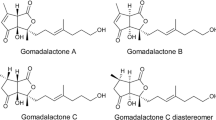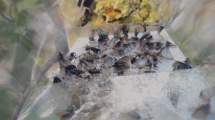Summary
The geometric isomers (E,E)-, (E,Z)-, (Z,E)-, and (Z,Z)-8,10-dodecadien-1-yl acetate were identified as sex pheromone components or sex attractants in the tribes Eucosmini and Grapholitini of the tortricid subfamily Olethreutinae. Species belonging to the more ancestral Tortricinae were not attracted. Each one isomer was behaviourally active in males ofCydia andGrapholita (Grapholitini), either as main pheromone compound, attraction synergist or attraction inhibitor. Their reciprocal attractive/antagonistic activity in a number of species enables specific communication with these four compounds.Pammene, as well as otherGrapholita andCydia responded to the monoenic 8- or 10-dodecen-1-yl acetates. Of the tribes Olethreutini and Eucosmini,Hedya, Epiblema, Eucosma, andNotocelia trimaculana were also attracted to 8,10-dodecadien-1-yl acetates, but several otherNotocelia to 10,12-tetradecadien-1-yl acetates. The female sex pheromones ofC. fagiglandana, C. pyrivora, C. splendana, Epiblema foenella andNotocelia roborana were identified. (E,E)- and (E,Z)-8,10-dodecadien-1-yl acetate are producedvia a commonE9 desaturation pathway inC. splendana. CallingC. nigricana andC. fagiglandana females are attracted to wingfanning males.
Similar content being viewed by others
References
Arn H, Rauscher S, Schmid A (1979) Sex attractant formulations and traps for the grape mothEupoecilia ambiguella Hb. Mitt schweiz entomol Ges 52:49–55
Arn H, Guerin PM, Buser H-R, Rauscher S, Mani E (1985) Sex pheromone blend of the codling moth,Cydia pomonella: evidence for a behavioural role of dodecan-1-ol. Experientia 41:1482–1483
Arn H, Tóth M, Priesner E (1992) List of sex pheromones of Lepidoptera and related attractants. 2nd ed. F-Montfavet: International Organization for Biological and Integrated Control
Arn H, Tóth M, Priesner E (1995) The Pherolist. Internet edition: Http://www.nysaes.cornell.edu/pheronet
Baker TC, Cardé RT (1979) Courtship behavior of the Oriental fruit moth (Grapholitha molesta): experimental analysis and consideration of the role of sexual selection in the evolution of courtship pheromones in the Lepidoptera. Ann entomol Soc Am 72:173–188
Baker TC, Nishida R, Roelofs WL (1981) Close-range attraction of female Oriental fruit moth to herbal scent of male hairpencils. Science 214:1359–1361
Bell EA (1972) Toxic amino acids in the Leguminosae. Pp 163–177in Harborne JB (ed.) Phytochemical Ecology. GB-London: Academic Press
Bengtsson M, Liljefors T, Hansson BS, Löfstedt C, Copaja SV (1990) Structure-activity relationships for chain-shortened analogs of (Z)-5-decenyl acetate, a pheromone component of the turnip moth,Agrotis segetum. J chem Ecol 16:667–684
Bengtsson M, Karg G, Kirsch PA, Löfqvist J, Sauer A, Witzgall P (1994) Mating disruption of pea mothCydia nigricana F. (Lepidoptera: Tortricidae) by a repellent blend of sex pheromone and attraction inhibitors. J chem Ecol 20:871–887
Booij CJH, Voerman S, Willemse LPM (1986) Conifer-infesting tortricids in Western Europe: A search for more potent and selective sex attractants. Z angew Entomol 102:253–259
Bournoville R (1979) Determination, au champ, d'attractifs sexuels de synthèse des mâles de deux Tortricidae (Lep):Laspeyresia medicaginis Kuzn. etLaspeyresia nigricana F., nuisibles aux legumineuses cultivées. Rev Zool agric Pathol vég 78:41–48
Bovey P (1966) Super-famille des Tortricoidea. Pp 456–893in Balachowsky AS (ed.) Entomologie Appliquée à l'Agriculture, Vol. II. F-Paris: Masson
Bradley JD, Tremewan WG, Smith A (1973) British Tortricoid Moths. Cochylidae and Tortricidae: Tortricinae. GB-London: The Ray Society
Bradley JD, Tremewan WG, Smith A (1979) British Tortricoid Moths. Tortricidae: Olethreutinae. GB-London: The Ray Society
Brown RL (1984) Review of Corticivora (Lepidoptera: Tortricidae) with analysis of its tribal relationships and descriptions of new species. Proc entomol Soc Wash 86:278–286
Burmann K, Pröse H (1988) Eine neueCydia aus den Südalpen:Cydia cytisanthana n. sp. St Trent Sci Nat 64:191–199
Butlin R (1994) Genetic variation in mating signals and responses. Pp 327–366in Lambert DM, Spencer H (eds) Speciation and the Recognition Concept: Theory and Application. Baltimore/MD: Johns Hopkins Univ Press
Cardé RT, Cardé AM, Hill AS, Roelofs WL (1977) Sex attractant specificity as a reproductive isolating mechanism among the sibling speciesArchips argyrospilus andmortuanus and other sympatric tortricine moths (Lepidoptera: Tortricidae). J chem Ecol 3:71–84
Castrovillo PJ, Cardé RT (1980) Male codling moth (Laspeyresia pomonella) orientation to visual cues in the presence of pheromone and sequences of courtship behaviors. Ann entomol Soc Am 73:100–105
Chambon JP, Witzgall P, Bengtsson M (1993) Une nouvelle tordeuse en Turquie,Cydia turcianae n. sp. (Lepidoptera, Tortricidae). Bull Soc entomol France 98:181–183
Chisholm MD, Reed DW, Underhill EW, Palaniswamy P, Wong JW (1985) Attraction of tortricid moths of subfamily Olethreuthinae to field traps baited with dodecadienes. J chem Ecol 11:217–229
Christensen TA, Hildebrand JG (1994) Neuroethology of sexual attraction and inhibition in heliothine moths. Pp 37–46in Schildberger K, Elsner N (eds) Fortschritte der Zoologie 39: Neural Basis of Behavioural Adaptations. D-Stuttgart: Gustav Fischer
Coyne JA, Orr HA, Futuyma DJ (1988) Do we need a new species concept? Syst Zool 37:190–200
Danilevskij AS, Kuznetsov VI (1968) Listovertki Tortricidae: triba plodozhorki Laspeyresiiniin Fauna SSSR, Nasekomye Tcheshuekrylye. Vol. 5. Leningrad: Nauka
Davis HG, McDonough LM, Burditt Jr AK, Bierl-Leonhardt BA (1984) Filbertworm sex pheromone. Identification and field tests of (E,E)- and (E,Z)-8,10-dodecadien-1-ol acetates. J chem Ecol 10:53–61
Du G, Prestwich GD (1995) Protein structure encodes the ligand binding specificity in pheromone binding proteins. Biochemistry 34:8726–8732
Foster SP, Dugdale JS, White CS (1991) Sex pheromones and the status of greenheaded and brownheaded leafroller moths in New Zealand. N Z J Zool 18:63–74
Frérot B, Priesner E, Gallois M (1979) A sex attractant for the green budworm moth,Hedya nubiferana. Z Naturforsch 34c:1248–1252
Frérot B, Marro JP, Malosse C (1995)In vitro incubation of sex pheromone gland and identification of pheromone components inCydia splendana (Hb). C R Acad Sc Paris 318(III):447–451
Greenway AR (1984) Sex pheromone of the pea moth,Cydia nigricana (F.) (Lepidoptera: Olethreutidae). J chem Ecol 10:973–982
Guerin PM, Arn H, Blaser C, Lettéré M (1983)Z,E-8,10-dodecadien-1-ol, attractant for malePammene rhediella. Entomol exp appl 33:346–347
Guerin PM, Arn H, Buser HR, Charmillot P, Tóth M, Sziráki G (1986) Sex pheromone ofGrapholita funebrana. Occurrence ofZ-8- andZ-10-tetradecenyl acetate as secondary components. J chem Ecol 12:1361–1368
Horak M, Brown RL (1991) Taxonomy and phylogeny. Pp 23–48in van der Geest LPS, Evenhuis HH (eds) Tortricid Pests, their Biology, Natural Enemies and Control. NL-Amsterdam: Elsevier
Jones DA (1972) Cyanogenic glycosides and their function. Pp 103–124in Harborne JB (ed.) Phytochemical Ecology. GB-London: Academic Press
Katovich SA, Swedenborg PD, Giblin M, Underhill EW (1989) Evidence for (E,Z)-8,10-dodecadienyl acetate as the major component of the sex pheromone of the eastern pine seedworm,Cydia toreuta (Lepidoptera: Tortricidae). J chem Ecol 15:581–590
Lambert DM, Michaux B, White CS (1987) Are species self-defining? Syst Zool 36:196–205
Linn CE, Roelofs WL (1994) Pheromone communication in moths and its role in the speciation process. Pp 263–300in Lambert DM, Spencer H (eds) Speciation and the Recognition Concept: Theory and Application. Baltimore/MD: Johns Hopkins Univ Press
Linn Jr CE, Campbell MG, Roelofs WL (1986) Male moth sensitivity to multicomponent pheromones: critical role of female-released blend in determining the functional role of components and active space of the pheromone. J chem Ecol 12:659–668
Löfstedt C (1993) Moth pheromone genetics and evolution. Phil Trans R Soc Lond B 340:167–177
Löfstedt C, Bengtsson M (1988) Sex pheromone biosynthesis of (E,E)-8,10-dodecadienol in codling mothCydia pomonella involvesE9 desaturation. J chem Ecol 14:903–915
Löfstedt C, Vickers NJ, Roelofs WL, Baker TC (1989) Diet related courtship success in the Oriental fruit moth,Grapholita molesta (Tortricidae). Oikos 55:402–408
McDonough LM, Eikenbary RD, Smith MT, Davis HG, Smithhisler CL, Hedger GA, Campbell RK, Payne JA, Reid W, McVay JR (1990) Sex pheromone of hickory shuckwormCydia caryana. Development of an effective field lure. J chem Ecol 16:317–324
Miller WE (1990) Body size and diet quality in the genusCydia (Tortricidae). J Lep Soc 44:113–142
Nishida R, Baker TC, Roelofs WL (1982) Hairpencil pheromone components of male Oriental fruit moths,Grapholita molesta. J chem Ecol 8:947–959
Nishida R, Fukami H, Baker TC, Roelofs WL, Acree TE (1985) Oriental fruit moth pheromone: attraction of females by an herbal essence. Pp 47–63in Acree TE, Soderlund DM (eds) Semiochemistry: Flavors and Pheromones. D-Berlin: de Gruyter
Obratsov NS (1959) Die Gattungen der palaearktischen Tortricidae. II. Die Unterfamilie Olethreutinae. 2. Teil. Tijdschr Entomol 102:175–215
Obratsov NS (1965) Die Gattungen der palaearktischen Tortricidae. II. Die Unterfamilie Olethreutinae. 6. Teil. Tijdschr Entomol 108:365–387
Paterson HEH (1985) The recognition concept of species. Pp 21–29in Vrba ES (ed.) Species and Speciation. Pretoria: Transvaal Museum Monograph No. 4
Phelan PL (1992) Evolution of sex pheromones and the role of assymetric tracking. Pp 265–314in Roitberg BD, Isman MB (eds) Insect Chemical Ecology: An Evolutionary Approach. New York: Chapman & Hall
Priesner E (1979) Specificity studies on pheromone receptors of noctuid and tortricid Lepidoptera. Pp 57–71in Ritter FJ (ed.) Chemical Ecology: Odour Communication in Animals. NL-Amsterdam: Elsevier
Priesner E (1986) Correlating sensory and behavioural responses in multichemical pheromone systems of Lepidoptera. Pp 225–233in Payne TL, Birch MC, Kennedy CEJ (eds) Mechanisms in Insect Olfaction. GB-Oxford: Clarendon
Razowski J (1976) Phylogeny and system of Tortricidae (Lepidoptera). Acta zool Cracov 21:73–120
Razowski J (1989) The genera of Tortricidae (Lepidoptera). Part II: Palaearctic Olethreutinae. Acta zool Cracov 32:107–328
Razowski J (1990) Abdominal scent organs in Tortricidae (Lepidoptera). Acta zool Cracov 33:521–554
Reed DW, Chisholm MD (1985) Attraction of moth species of Tortricidae, Gelechiidae, Geometridae, Drepanidae, Pyralidae, and Gracillariidae families to field traps baited with conjugated dienes. J chem Ecol 11:1645–1657
Roelofs WL, Brown RL (1982) Pheromones and evolutionary relationships of Tortricidae. Annu Rev Ecol Syst 13:395–422
Roelofs WL, Glover T, Tang X-H, Sreng I, Robbins P, Eckenrode C, Löfstedt C, Hansson BS, Bengtsson B-O (1987) Sex pheromone production and perception in European corn borer moths is determined by both autosomal and sex-linked genes. Proc Natl Acad Sci 84:7585–7589
Rotundo G, Giacometti R (1988) Individuazione di una miscela attrattiva per maschi diCydia fagiglandana Z. (Lep. Tortricidae) mediante studio di campo. Boll Lab entomol agr Portici 45:81–97
Silk PJ, Kuenen LPS (1988) Sex pheromones and behavioral biology of the coniferophagousChoristoneura. Annu Rev Entomol 33:83–101
Streinz L, Horak A, Vrkoc J, Hrdy I (1993) Propheromones derived from codlemone. J chem Ecol 19:1–9
Swatschek B (1958) Die Larvalsystematik der Wickler (Tortricidae und Carposinidae). D-Berlin: Akademie-Verlag
Wakamura S (1985) Identification of sex-pheromone components of the podborer,Matsumuraeses falcana (Walsingham) (Lepidoptera: Tortricidae). Appl Entomol Zool 20:189–198
Wall C (1988) Application of sex attractants for monitoring the pea moth,Cydia nigricana (F.) (Lepidoptera: Tortricidae). J chem Ecol 14:1857–1866
White CS, Lambert DM, Foster SP (1994) Chemical signals and the recognition concept. Pp 301–326in Lambert DM, Spencer H (eds) Speciation and the Recognition Concept: Theory and Application. Baltimore/MD: Johns Hopkins Univ Press
Witzgall P, Priesner E (1991) Wind tunnel study on an attraction inhibitor in maleColeophora laricella (Lepidoptera: Coleophoridae). J chem Ecol 17:1355–1362
Witzgall P, Frérot B, Malosse C (1991) Identification du composé majoritaire de la sécrétion phéromonale deNotocelia uddmanniana L. (Lep., Tortricidae). J appl Entomol 112:71–75
Witzgall P, Bengtsson M, Unelius CR, Löfqvist J (1993) Attraction of pea mothCydia nigricana F. (Lepidoptera: Tortricidae) to female sex pheromone (E,E)-8,10-dodecadien-1-yl acetate, is inhibited by geometric isomersE,Z, Z,E andZ,Z. J chem Ecol 19:1917–1928
Witzgall P, Bengtsson M, Karg G, Bäckman A-C, Streinz L, Kirsch PA, Blum Z, Löfqvist J (1996a) Behavioral observations and measurements of aerial pheromone concentrations in a mating disruption trial against pea mothCydia nigricana F. (Lepidoptera, Tortricidae). J chem Ecol 22:191–206
Witzgall P, Bäckman A-C, Svensson M, Bengtsson M, Unelius CR, Vrkoc J, Kirsch PA, Ioriatti C, Löfqvist J (1996b) Potential of a blend ofE8,E10–12OH andE8,E10–12Ac for mating disruption of codling moth,Cydia pomonella L. (Lep., Tortricidae). J appl Entomol: in press
Author information
Authors and Affiliations
Rights and permissions
About this article
Cite this article
Witzgall, P., Chambon, JP., Bengtsson, M. et al. Sex pheromones and attractants in the Eucosmini and Grapholitini (Lepidoptera, Tortricidae). Chemoecology 7, 13–23 (1996). https://doi.org/10.1007/BF01240633
Issue Date:
DOI: https://doi.org/10.1007/BF01240633




